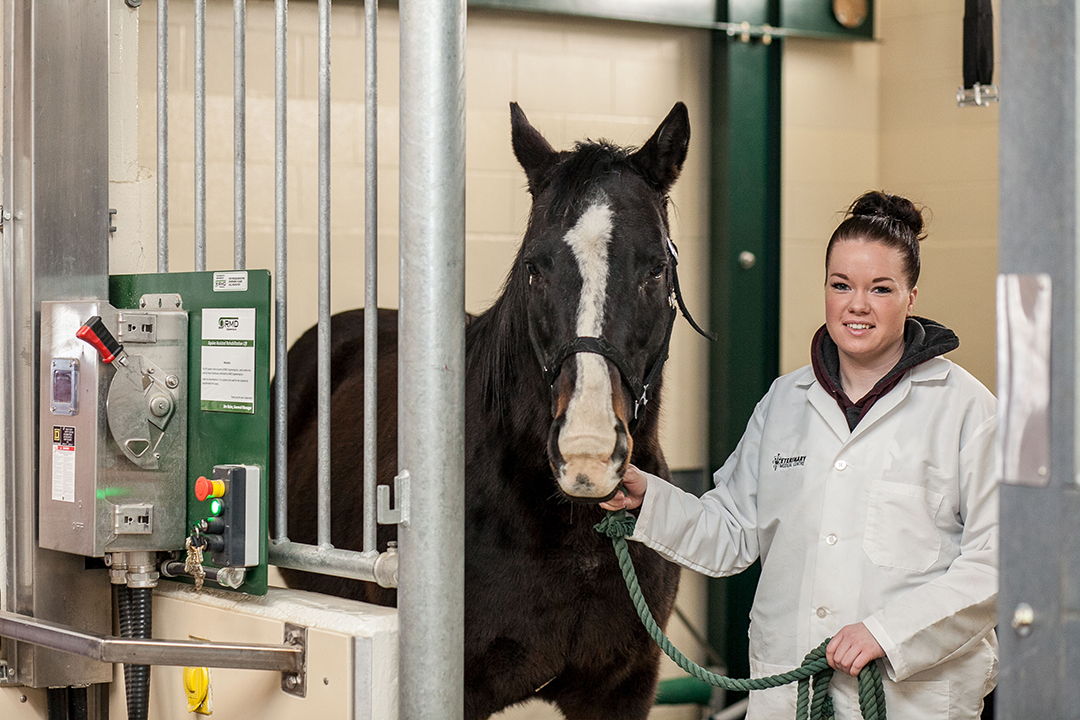
Master’s student finds One Health links in equine research
Samantha Steinke’s academic career is the perfect example of how embracing the links between human and animal health can lead to unexpected opportunities.
By WCVM TodaySteinke was working on an undergraduate degree in physiology and pharmacology at the University of Saskatchewan (USask) when she heard about a unique project underway at the Western College of Veterinary Medicine (WCVM).
Dr. Julia Montgomery, an associate professor in the WCVM’s Department of Large Animal Clinical Sciences, had begun testing a lift system designed to help horses heal from injuries using the Anderson Sling, a commercially available rescue sling.
Steinke had recently lost her own horse after a debilitating injury, and she reached out to Montgomery to see if she could get involved in the research project.
This turned into an honours project for Steinke, who is now continuing her research as a master’s student in the USask College of Engineering’s Division of Biomedical Engineering. Steinke began developing a unique rehabilitation harness to be paired specifically with the lift as part of her honours project and has continued to refine the technology during her master’s fellowship – collaborating with engineers and computer programmers.
She has also begun a project that uses Apple Watch and other camera technology to monitor movement while rehabilitating horses.
Steinke works hard to seek out collaborations, attending interdisciplinary conferences to further her knowledge in human and animal rehabilitation. She sees One Health — the connection between human, animal and environmental health — as an essential part of her work.
How did you become interested in One Health?
I’ve always believed there’s a strong connection between human and animal health and the environment. Lots of animals and human disease are similar and can be passed along. I feel like animals can have a huge benefit for human health as well.
How does your work fit within the idea of One Health?
Originally the project began because a lady with multiple sclerosis (MS) was interested in having more independent ability to move around her house. But Health Canada did not support the testing, so RMD Engineering came to the WCVM and asked them if it [the research project] would be useful for any of the animals they are treating. Dr. Montgomery was in support of the project and really wanted to be involved. We started testing in horses, and hopefully the rehabilitation harness and lift can be transferred back to humans to help with human health as well.
What opportunities are there for exploring One Health at USask?
I believe there’s lots of opportunity. Because we have human health and animal health all here, as well as agriculture and environment, there’s so much ability for people to have collaborations and work together — it’s just making those connections. That’s why I’ve really been pushing to go to lots of conferences, human conferences and multi-disciplinary conferences so that I can hopefully make those connections and start working together.
What should students interested in One Health do to further their careers?
I think reaching out and making those connections is important for people who are interested in One Health. You never know what’s out there until you reach out and start networking with people. I never thought I’d be here — it was just a personal experience. Sometimes you don’t always know what you want to do, but if you reach out and you get those experiences, you might find something you never thought you’d do be something you end up doing.
Where do you want to take your work in the future?
I’d like to stay in [the] rehabilitation of horses — muscle and bone injuries in the legs — because I have a passion for that now. It’s a very important area for horses because their legs are so important … they heavily depend on having healthy legs to get around and live. I think that’s a very important area for research.
